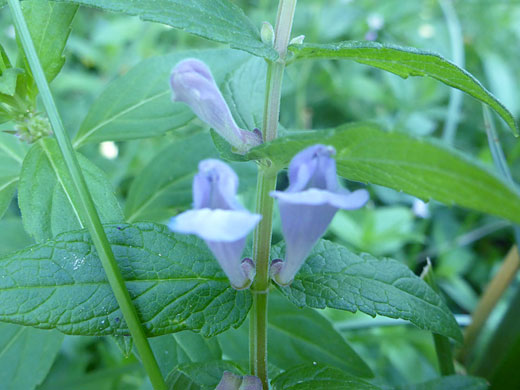Scutellaria Galericulata, Marsh Skullcap
Plants > Wildflowers > Lamiaceae > Scutellaria Galericulata

Hairy, pale blue flowers of scutellaria galericulata, along the Two Ocean Lake Trail, Grand Teton National Park, Wyoming
Common name:
Marsh skullcap
Family:
Scientific name:
Scutellaria galericulata
Main flower color:
Range:
All the western states; least common in California and the southern Great Plains
Height:
Up to 30 inches
Habitat:
Moist woodland, streambanks, lakeshores; generally wet locations, from near sea level to 8,000 feet
Leaves:
Opposite, ovate to narrowly lanceolate, up to 2.5 inches long
Season:
June to August
Stems of scutellaria galericulata are erect, square in cross-section, and either glabrous or covered by very short hairs, which point downwards; these are most noticeable along the edges. Leaves are generally not found at the base, only along the stem, in opposite pairs, about one inch apart. Leaf edges may be entire or coarsely, shallowly toothed. Upper stem leaves are sessile, while those towards the base have short petioles, up to 0.2 inches. Upper leaf surfaces are intricately veined, and somewhat shiny.
Flowers are produced in pairs from the leaf nodes; they have a short, greenish purple calyx and a much larger, blue or pale violet corolla, up to 0.8 inches long. The corolla opens to an arched, constricted upper lip and a wider, slightly recurved lower lip. Four equal-length stamens are contained within the upper lip. The lower lip is mottled with flecks of darker color, and its inner surface has a bumpy texture. The outside of the corolla has a dense covering of short hairs. Usually two or three pairs of flowers are in bloom at any one time.
Flowers are produced in pairs from the leaf nodes; they have a short, greenish purple calyx and a much larger, blue or pale violet corolla, up to 0.8 inches long. The corolla opens to an arched, constricted upper lip and a wider, slightly recurved lower lip. Four equal-length stamens are contained within the upper lip. The lower lip is mottled with flecks of darker color, and its inner surface has a bumpy texture. The outside of the corolla has a dense covering of short hairs. Usually two or three pairs of flowers are in bloom at any one time.
All Contents © Copyright The American Southwest | Comments and Questions | Contribute | Site Map

